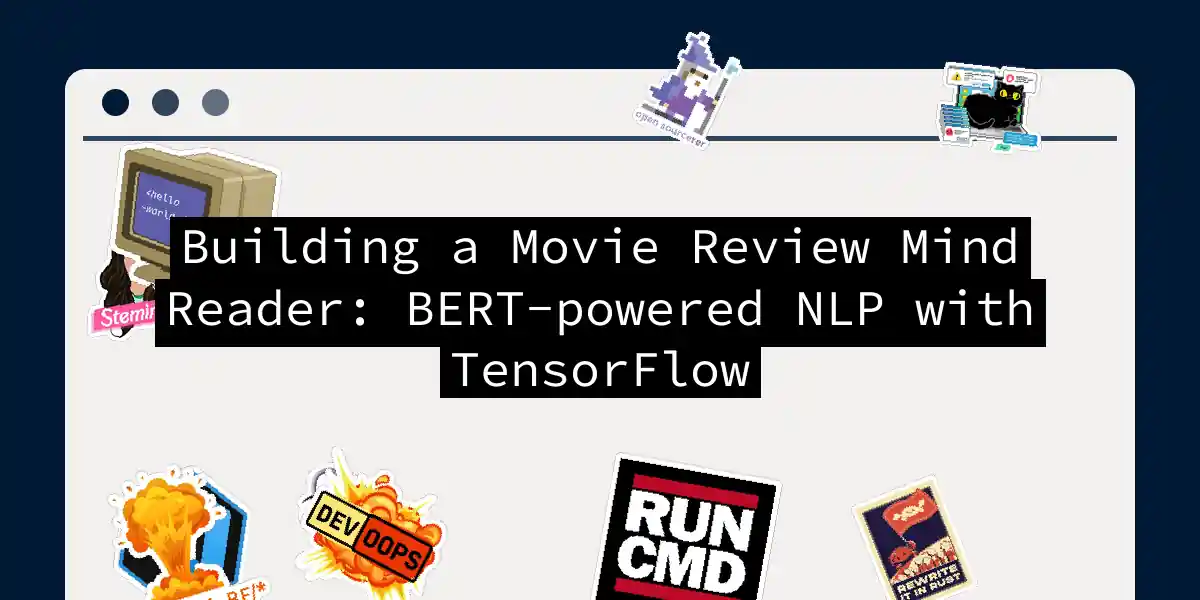Ah, natural language processing - the art of making machines understand human speech, or as I like to call it, “teaching robots to appreciate Shakespeare while they silently judge your text messages.” Today we’ll build a system that can predict whether a movie review is positive or negative using BERT and TensorFlow. Why? Because sometimes you need to know if “This film changed my life” actually means they’ll never get those 2 hours back.
1. Kitchen Setup: Ingredients & Tools
Before we teach our AI to be a film critic, let’s set up our digital kitchen. You’ll need:
# The holy trinity of modern AI cooking
import tensorflow as tf
import tensorflow_hub as hub
import tensorflow_text as text # The secret sauce for text preprocessing
# Our personal chef for model construction
from tensorflow.keras.layers import Dense, Input
from tensorflow.keras.models import Model
Pro tip: If your computer starts whimpering when loading BERT, remember - great power requires great thermal paste. Maybe ease up on the browser tabs?
2. Data Preprocessing: Making Word Salad Edible
BERT’s like that friend who needs their pizza cut exactly 8.5 degrees clockwise. Let’s prepare our text data properly:
Here’s how we create our text processing conveyor belt:
bert_preprocess = hub.KerasLayer(
"https://tfhub.dev/tensorflow/bert_en_uncased_preprocess/3",
name="text_preprocessor")
Think of this as the world’s most opinionated pizza cutter - it slices text into BERT-digestible pieces with military precision.
3. Building Our Digital Film Critic
Time to assemble our cyborg Roger Ebert. We’ll use the BERT equivalent of a souped-up Honda Civic - small but surprisingly powerful:
# Our BERT model's personal LinkedIn URL
BERT_ENCODER = "https://tfhub.dev/tensorflow/small_bert/bert_en_uncased_L-4_H-512_A-8/1"
# Constructing our review analysis machine
text_input = Input(shape=(), dtype=tf.string, name="text_input")
preprocessed_text = bert_preprocess(text_input)
bert_output = hub.KerasLayer(BERT_ENCODER, trainable=True)(preprocessed_text)
# The decision-making layer (where the magic happens)
decision_head = Dense(1, activation='sigmoid', name="classifier")(bert_output['pooled_output'])
# Our final model: From words to verdict
model = Model(inputs=text_input, outputs=decision_head)
This architecture is like training a tiny robot to read reviews through a magnifying glass while shouting its opinions at us. Efficient? Maybe. Fun? Absolutely.
4. Training: Teaching Subtlety to a Sledgehammer
BERT models are like overeager interns - they need careful guidance to avoid over-enthusiastic generalization:
# Compile with the precision of a film student defending their favorite arthouse movie
model.compile(
optimizer=tf.keras.optimizers.Adam(learning_rate=3e-5),
loss='binary_crossentropy',
metrics=['accuracy'])
# The moment of truth (or 63% accuracy)
model.fit(
train_dataset.shuffle(1000).batch(16),
epochs=3,
validation_data=val_dataset.batch(16))
Remember: If your validation loss starts rising, that’s not failure - it’s the model developing its own unique interpretation of cinema. Probably.
5. Prediction Time: Becoming the Oracle of Opinions
Let’s test our creation with some reviews that capture the human experience:
sample_reviews = [
"This film redefined cinema while curing my seasonal allergies... 10/10!",
"I'd rather watch paint dry while listening to Nickelback.",
"The cinematography was... existent."
]
predictions = model.predict(tf.constant(sample_reviews))
Our model will output probabilities that we’ll interpret as:
0.7: Positive (They’ll tell all their friends)
- <0.3: Negative (They’ll tell all their enemies)
- 0.3-0.7: “I have complex feelings about my childhood”
The BERT Whisperer’s Survival Guide
While training, keep these tips in mind:
- Learning Rate: Start small (3e-5) unless you enjoy AI-generated abstract poetry
- Batch Size: Keep it small enough to avoid VRAM-induced existential crises
- Dropout: The digital equivalent of “sleeping on it” for neural networks Remember: Fine-tuning BERT is like adopting a highly educated wolf. It knows more than you about language structure, but you still need to teach it bathroom manners (domain adaptation). So there you have it - your personal movie review mind-reading machine! Will it revolutionize cinema? Unlikely. Will it impress your cat? Absolutely. Now go forth and classify texts with the confidence of someone who’s mastered the art of teaching transformers to understand human emotions (or at least mimic that understanding convincingly).
